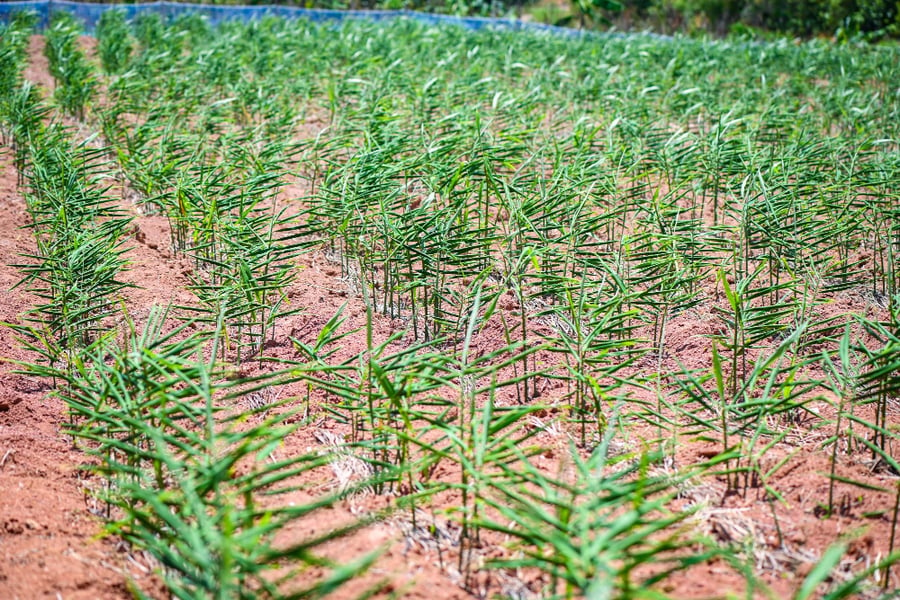Ginger has been grown for more than 5000 years and through time has been considered something of a luxury. The ancient civilizations of China and India used the root as a tonic to treat many ailments. Ginger is a potent anti-inflammatory and inflammation is the cause of many of the problems that can strike down human beings. Even today, medical scientists explore the properties of ginger and its health benefits (Medical News Today). There is evidence to suggest that it can relieve nausea, improve appetite, prevent motion sickness, as well as reduce pain.
Although the value of ginger has decreased over the years, as has the monetary value of most spices, it is still a valued ingredient in the kitchen. You will find ginger in your local stores. Yet, why would you bother buying it when you can quickly grow it in your garden? Even though your crop might not give you the same value as a live sheep or other livestock, as it would have done in the 14th century, it will serve to make your curries taste amazing. Fortunately, growing ginger at home is more than doable, especially in a polytunnel! Find out how to grow ginger at home in this simple guide.
Ginger may be native to India, China and Southeast Asia, but you absolutely can grow ginger in the UK. Of course, since it naturally grows in tropical climates, ginger loves humidity. Therefore, although ginger is relatively easy to grow, you will find your crop will improve significantly in a First Tunnels polytunnel.
The autumn and winter weather in the UK can prove too cold for ginger, but if you provide it with a little extra warmth and a lot of moisture in the air, you will find that learning how to grow ginger at home is surprisingly easy!
However, remember you are growing the ginger most likely to harvest the rhizomes, which is the root that can be grated into food. Therefore, maintaining the soil balance and moisture is essential to the success of your crop. This means that the close control of the environment offered by a polytunnel can bring much success.
Additionally, ginger does not require too much space. Therefore, you can opt for the 6ft x 8ft polytunnel, which easily fits into smaller gardens, while offering you the perfect environment for your ginger. However, do not underestimate the taste that can be extracted from the ginger stems. These stems are considered an exotic ingredient in Asia. Your polytunnel can recreate the ideal growing conditions for these stems, matching the native environment in Asia.
Ultimately, ginger cannot grow in an environment that is liable to frost, strong winds, and soggy and water-logged soils. It will also struggle in direct sunlight. Therefore, your polytunnel will provide the appropriate shelter from these conditions and improve your ginger harvest. You can make sure your polytunnel has the perfect tropical environment by using a polytunnel heater.

Despite the many things ginger does not enjoy, it is relatively easy to grow. Although a tropical plant, it does not require expert knowledge to cultivate a successful crop. Here’s how to grow ginger at home in four simple steps:
First, buy a rhizome of ginger. You can buy this from the supermarket, as it is just a fresh piece of ginger root. You need to select a piece from the supermarket that has been well-developed. You need to look to see if there are growth buds on the ginger – which are small nodules similar to what would begin to appear on potatoes.
Next, soak your ginger root in water. Supermarkets prolong the life of ginger root by spraying them with a growth retardant, which prevents the nodules from growing. Therefore, soaking in water for a day or so to wash this away is perfectly sensible. However, soaking the root in water until the roots show is counterproductive. The sprouting roots will be much happier in the soil, where they can breathe appropriately from the start, and you do not disturb them by transplanting them later. Remember if the ground is moist and warm, the rhizome will easily root.
Then, break your ginger root into pieces, with each part containing a growth bud. You then need to plant these in a seed tray, in moist potting compost. You will need to feed these and provide good drainage. A good time to start this process is the end of winter. However, if continuing to grow the plant indoors, you can complete this process at any time of year. Remember, if your ginger is going outdoors, the plant is not winter hardy. Be aware that any heating, especially central heating, can dry out the air. Therefore, you should spray the plant with moisture regularly to increase the level of humidity.
Once seeded, you can transplant these into a pot or the ground. You need excellent soil, which is rich in nutrients and full of moisture if your ginger is to thrive. The soil needs to be free draining; else the roots could rot. However, there needs to be adequate water to feed its thirsty ways.
Now you know to how to grow ginger at home! As long as your ginger gets the much-needed light and warmth, then within eight to ten months, your ginger plant will be fully grown. The plant, at its tallest, with be about a metre and a half. Therefore, you will need to leave enough height for it to mature. Its spread is limited. Remember the root is the spice we are used to using in our food. So, you may want to save some of your roots for replanting your next crop.
Once the ginger is about four months old, you can begin to steal little bits of it as you go. The ginger will grow in clumps, which means you can carefully dig away a small portion of the plant and root and leave the rest to grow. Green, under mature ginger, does not have the same taste as fully matured ginger. Therefore, if you can wait, you should.
The best approach to harvesting ginger is:
If you are serious about cultivating a crop of ginger, then leave the plants for two years or so. You can then build up a stock. The plant will continue to spread outwards, and once you start harvesting, you can dig into the central clump of the plant. By choosing the older roots in the centre, you will leave the younger shoots free to grow and provide your next crop.
| Sowing Time | Late winter/early spring |
|---|---|
| Harvesting Time | Eight to ten months after sowing, if waiting for the plant to mature fully |
The great news about learning how to grow ginger at home is that it is easy to grow – in the right conditions. You can easily set up a system of harvesting and planting, which means you keep your ginger plants in a cycle of planting, growing and harvest. Remember, all you need is well-drained, moist soil that is free from the worst of UK weather – the rest can be left to nature.
